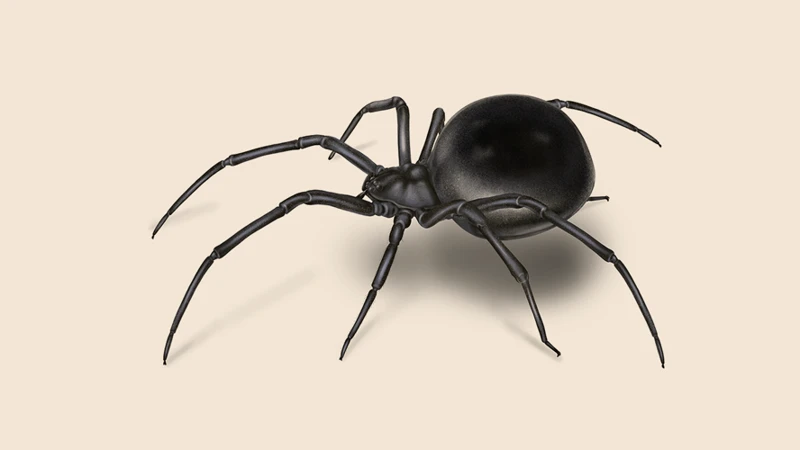As a spider enthusiast or simply as someone who wants to stay safe from the potentially poisonous black widow spider, you may be wondering how to differentiate between the different types of this spider. With so many different species and subspecies of black widow spider, it can be difficult to know which ones are dangerous and which ones are harmless. But don’t worry, in this article we will delve into the physical characteristics, geographic locations, behaviors, habitats, and distinguishing features of various types of black widow spiders. By the end of this article, you will have a better understanding of how to identify the different types and what steps to take to stay safe.
Physical Characteristics
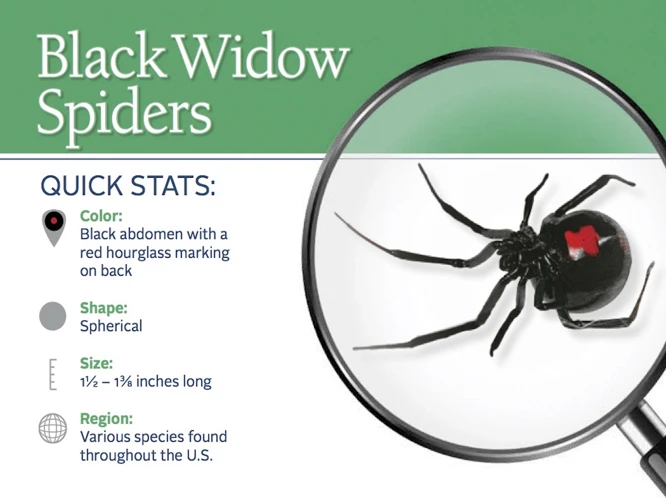
When it comes to identifying black widow spiders, it’s important to understand their physical characteristics. These fascinating creatures possess various features that make them easy to distinguish from other spiders. Their unique anatomy, including their fangs, exoskeleton, and sensory capabilities, all play a role in differentiating between different types of black widows. In this section, we’ll delve into their coloration, size variability, and identifying markings, which are essential traits to recognize in order to properly distinguish between species.
Body Shape and Size
Black widow spiders are characterized by their distinctive appearance, which varies slightly depending on the species. Body shape and size is one of the most important factors in identifying black widow spiders. In general, female black widows are larger than males, with more elongated bodies and larger venom glands.
To further illustrate these differences, the table below compares the body shape and size of the four most common species of black widow spiders:
| Species | Body Shape | Female Length (including legs) | Male Length (including legs) |
|---|---|---|---|
| Southern Black Widow | Elongated, spherical abdomen | up to 1.5 inches | about half the size of female |
| Northern Black Widow | Spherical abdomen | up to 1.5 inches | about half the size of female |
| Western Black Widow | Elongated, spherical abdomen | up to 1.5 inches | about half the size of female |
| Red Widow | Spherical abdomen | up to 1 inch | about half the size of female |
As shown in the table, all black widow spider species have distinctively spherical or elongated spherical abdomens, with females being much larger than males. Knowing the body shape and size of black widow spiders can help in distinguishing them from other spider species. To learn about the anatomy of black widow spiders, including their fangs, exoskeleton, and sensory capabilities, click on the relevant links.
Coloration and Markings
Black Widow Spiders are known for their distinctive markings, which can help differentiate between different species. These markings are usually found on the abdomen and can vary in color and shape. In general, female black widows have more distinct markings than males and are the ones to watch out for, as they are the only ones that can cause harm to humans.
To better understand the coloration and markings of black widow spiders, we’ve created a table below:
| Species | Coloration | Markings |
|---|---|---|
| Southern Black Widow | Shiny black | Red markings on the abdomen in the shape of an hourglass or a dot |
| Northern Black Widow | Shiny black | Red markings on the abdomen in the shape of an hourglass or hourglass-like markings |
| Western Black Widow | Shiny black | Red hourglass or two red triangular-shaped markings on the abdomen |
| Red Widow | Shiny black to dark brown | Bright red markings on the abdomen in various patterns, including an hourglass shape or two red spots |
As you can see, the coloration of black widow spiders is generally shiny black, with some differences in markings on the abdomen. These markings are usually red in color and can take on different shapes depending on the species. The Southern Black Widow and Northern Black Widow both have hourglass-shaped markings or hourglass-like markings, while the Western Black Widow has either an hourglass or two triangular-shaped markings. The Red Widow, on the other hand, has bright red markings that can take on various patterns.
It’s important to note that juvenile black widows may have different coloration and markings than adult females. Juvenile black widows may have less distinct markings or markings that aren’t the typical red color. It’s important to also pay attention to the body shape and size when trying to identify black widow spiders.
If you want to learn more about the anatomy and physical characteristics of black widow spiders, check out our article on the anatomy of black widow spider fangs or understanding physical characteristics of black widow spiders.
Geographic Location
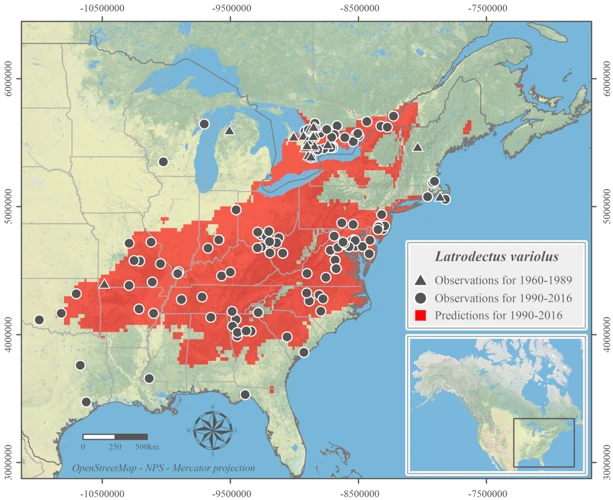
One of the most important factors to consider when trying to differentiate between the different types of black widow spiders is the geographic location where they are commonly found. Understanding the habitat and range of each species is crucial in identifying and distinguishing between them. From North to South America, black widow spiders can be found in a range of different environments, each with their own unique characteristics and challenges. For more information on spider body types and how to compare them, check out our article on spider body types comparison.
North America
North American Black Widows: Black widows are a common sight in North America. These spiders are usually found in warm and temperate climates, preferring dry and undisturbed areas such as sheds, woodpiles, garages, and basements. There are three main species of black widows found in North America – the Southern, Northern, and Western Black Widows.
To identify the black widow species found in North America, it is important to examine their physical characteristics. The coloration and size can help in determining the species. Southern black widows are usually shiny, jet black with a prominent red hourglass shape on the ventral side of their abdomen. Northern black widows are similar in appearance, but their hourglass marking is either red or yellow. Western black widows also have an hourglass marking, but it is usually in the shape of two connected triangles (rather than an hourglass).
Here is a table summarizing the distinguishing characteristics of the three species found in North America:
| Species | Coloration | Size | Hourglass Marking |
|---|---|---|---|
| Southern Black Widow | Shiny, jet black | 1-1.5 inches | Red hourglass on ventral abdomen |
| Northern Black Widow | Shiny, jet black | 0.5-1 inch | Red or yellow hourglass on ventral abdomen |
| Western Black Widow | Shiny, jet black | 0.5-1.5 inches | Two connected triangles on ventral abdomen |
It is important to note that while all black widows have venomous bites, they are not usually fatal unless the victim is a child or has a weak immune system. To avoid getting bitten, it is best to stay away from areas known to be frequented by these spiders, wear protective clothing, and take preventative measures such as spider control and regular inspections of your property.
If you want to learn more about the sensory capabilities of black widow spiders, click on this link.
South America
South America is home to many species of black widow spiders, with some of the most notable being the Chilean black widow (Latrodectus mactans), the Peruvian black widow (Latrodectus peruensis), and the Brazilian black widow (Latrodectus curacaviensis). These species are similar in appearance to North American black widows, with their characteristic red hourglass marking on the abdomen.
However, they also have distinct physical features that set them apart. For example, the Chilean black widow has a shiny black exoskeleton and may have white stripes on its back. Meanwhile, the Peruvian black widow is known for its large size, with females reaching up to 3 centimeters in length. The Brazilian black widow also has a large body size and may have markings that appear to be in the shape of a skull.
It’s important to note that while these spiders can be found in South America, they are also occasionally found in other parts of the world due to human transportation. So it’s important to be able to properly identify these spiders no matter where you live.
If you’re located in South America, it’s crucial to be aware of the potential risks of encountering black widow spiders. Educate yourself and your family on how to identify these spiders, their habits, and what to do if bitten. Remember, prevention is key. Use spider control methods to keep your home and yard free of spiders and their webs.
Fun fact: In some South American countries, black widow spider eggs are considered a delicacy and are even eaten raw.
For more information on identifying black widow spiders, check out our article on Identifying Black Widow Spider Eggs.
Behavior and Habitat
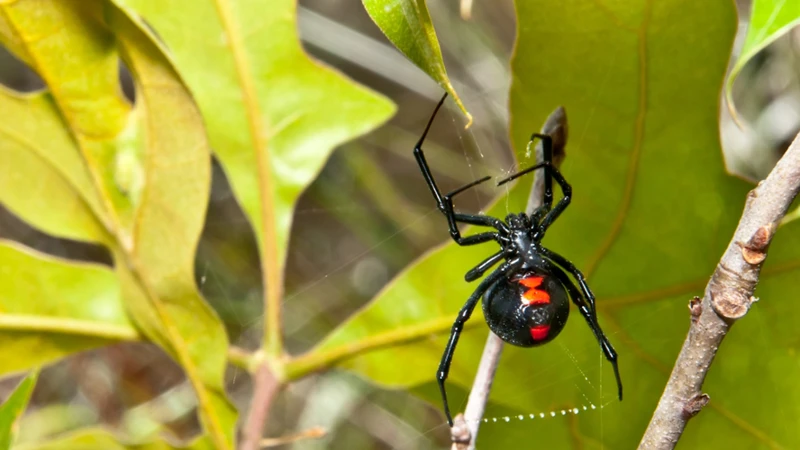
As one of the most notorious spiders in North and South America, Black Widow Spiders are known for their dangerous venom and distinct appearance. However, understanding the behavior and habitat of these arachnids is crucial for keeping yourself and your loved ones safe. Black Widows are typically shy and reclusive, preferring to hide away in their webs during the day. However, they can become aggressive if threatened or disturbed. Let’s dive deeper into the behavioral and habitat traits of Black Widow Spiders, including how to identify their webs and what to do in case of a bite. For more information on identifying the physical characteristics of these spiders, including coloration and markings, please visit this article.
Web Characteristics
Black widows are well known for their distinctive webs. Their webs are strong and irregular in shape, with no specific pattern. The silk used to create the web is elastic, allowing it to flex without breaking. A mature female black widow weaves a web that can stretch up to 2 feet in diameter, which can make it easy to spot in your garage, basement or other dark areas around your home.
When it comes to identifying a black widow spider web, there are a few key characteristics to look for. A black widow’s web usually has a funnel-like shape, with the spider at the deepest part of the funnel ready to strike at any unsuspecting prey. The webs are often located in dark, secluded areas such as under rocks or in crevices. It’s important to note that not all black widows create webs, as some prefer to hide in crevices or burrows and wait for prey to cross their path.
If you are trying to differentiate between different types of black widow spiders, take note of the web characteristics. There are slight variations in the web designs of different black widow species. For example, the Southern Black Widow’s web is usually irregular and messy, with no set pattern to the silk. Whereas, the Northern Black Widow’s web is more organized and neat, with a flat, tangled sheet of silk and an opening at the bottom leading into a funnel. The Western Black Widow’s web is similar to the Northern Black Widow’s in that it is flat and tangled, but it often has a zigzag pattern woven into it. The Red Widow’s web is similar to the Southern Black Widow’s web, but with a more twisted appearance resembling a ladder.
It’s important to always exercise caution when trying to identify any venomous spider. If you encounter a spider and are unsure of the species, it’s best to contact a professional for assistance. If you do spot a black widow spider or web in or near your home, it’s important to take preventative measures to avoid a potential bite. You can learn more about how to prevent and treat black widow spider bites in the Prevention and Treatment section of this article.
Image of spider web characteristics can be found at identifying-markings-black-widow-spiders.
Bite Symptoms and Severity
Black widow spiders have a reputation for being venomous, and their bites can be dangerous. The venom of a black widow is a neurotoxin that affects the victim’s nervous system, leading to severe symptoms. The severity of the symptoms depends on the location of the bite and the amount of venom injected.
| Bite Symptoms | Severity |
|---|---|
| Pain | The bite is extremely painful and can cause muscle spasms in the surrounding area. |
| Redness and Swelling | There may be redness and swelling around the bite area, signaling inflammation. |
| Nausea and Vomiting | Nausea and vomiting can occur as the venom affects the digestive system. |
| Sweating | The victim may experience excessive sweating as a result of the venom affecting the nervous system. |
| Headache | A headache may develop as the venom spreads through the body. |
| Fainting or Dizziness | These symptoms may indicate that the venom has caused a drop in blood pressure. |
If you suspect you have been bitten by a black widow spider, seek medical attention immediately. Medical treatment may include the use of antivenom and pain medication.
It is important to note that not all black widow bites result in severe symptoms. Juvenile black widows, for example, are less venomous than adult black widows, and their bites may be mild, causing only local pain and swelling. Additionally, the severity of the symptoms can vary depending on the size and species of the black widow. For more information on the size differences between black widows, see our article on size differences in black widows. Also, the black widow’s exoskeleton is designed to protect the spider in many ways and can also contribute to its venomous nature. Learn more about this in our article on the black widow’s exoskeleton.
Distinguishing between Species
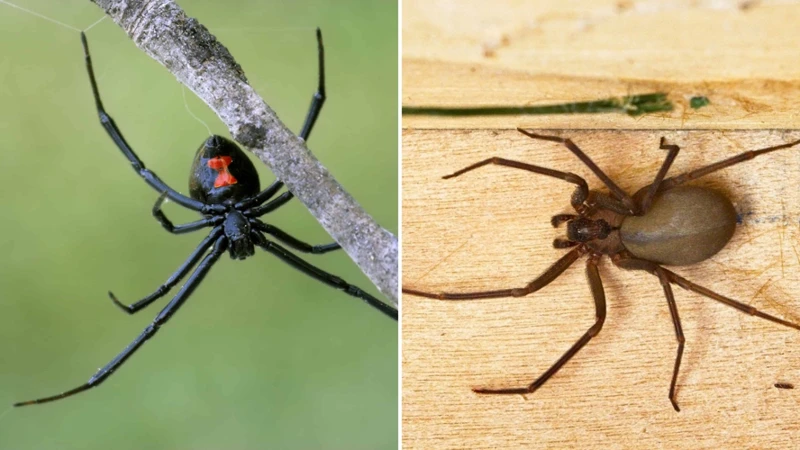
When it comes to identifying spiders, it’s important to know the differences between species, especially when it comes to black widows. Black widows are notorious for their venomous bites, and knowing the traits of each species can help you better protect yourself from these potentially dangerous arachnids. In this section, we will discuss the key characteristics of four different species of black widows – the Southern Black Widow, Northern Black Widow, Western Black Widow, and Red Widow. With this information, you will be able to distinguish between these species and identify the ones in your area. Additionally, if you want to learn more about juvenile black widow spider traits, click on the link to read our article on the topic.
Southern Black Widow
The Southern Black Widow is scientifically known as Latrodectus mactans and is found in the southeastern region of the United States. This species is highly venomous and known to bite humans. Here are some physical and behavioral characteristics that can help differentiate the Southern Black Widow from other species:
| Physical Characteristics | |
|---|---|
| Color: | The Southern Black Widow’s body is shiny and black, with a distinctive-red hourglass shape on its belly. |
| Size: | Female Southern Black Widows can grow up to 1.5 inches long, while males only grow up to half an inch long. Females are generally larger and more dangerous than males. |
| Web: | These spiders weave irregular webs, typically near the ground or in undisturbed areas like woodpiles or inside old tires. |
The Southern Black Widow’s venom affects the nervous system and can cause symptoms such as abdominal pain, muscle cramps, and tremors. In severe cases, the bite can lead to breathing difficulties and even paralysis. If you suspect that you have been bitten by a Southern Black Widow, it is important to seek medical treatment immediately.
To prevent a Southern Black Widow infestation, it is recommended that you remove any debris, like woodpiles, from around your home. Additionally, wear gloves when working outdoors in areas where spiders are likely to be present. If you find a spider in your home, carefully capture it in a container and release it outside.
If you want to learn more about the physical traits of juvenile black widow spiders, check out our article on juvenile black widow spider traits.
Northern Black Widow
The Northern Black Widow is a venomous spider native to North America with distinct physical characteristics that distinguish it from other species. Here are some key features to help you differentiate it from other black widow spiders:
- The female Northern Black Widow is identified by its shiny red hourglass-shaped marking on the underside of its abdomen. This marking is a unique characteristic of the Northern Black Widow, making it easy to distinguish from other black widow species.
- The males are less distinctive than the females, with markings that are less defined and lighter in color.
- Their bodies are black, and their legs are long and slender with fine hairs.
- Northern Black Widows prefer to live in dark, secluded areas such as garages, basements, and crawl spaces, making them a common household pest.
- They are more commonly found in northern regions of the United States and southern regions of Canada.
- Their webs are irregular and messy, and are often constructed in the corners of buildings or underneath outdoor furniture.
It is important to note that the Northern Black Widow’s bite can be extremely dangerous and should be treated immediately. Symptoms may include severe pain, muscle cramping, nausea, vomiting, and sweating. If you suspect you have been bitten by a Northern Black Widow, seek medical treatment right away.
Remember: Always exercise caution and seek professional help if you encounter a Northern Black Widow or any other venomous spider.
Western Black Widow
The Western Black Widow is one of the subspecies of the black widow spider, known for its venomous bite and distinguishable physical characteristics. Here are some key points that can help differentiate between the Western Black Widow and other black widow species:
- Coloration: The name itself suggests that the Western Black Widow is predominantly found in the western region of North America. It has a jet-black body with a red hourglass marking on its underside. However, the coloration of the red marking may sometimes vary from orange or yellow.
- Web Characteristics: The web structure of the Western Black Widow is extremely messy and chaotic, unlike the organized webs of other black widow subspecies. These spiders usually build their webs in dark and humid places and wait patiently for their prey to fall into the trap.
- Body Shape: The body shape of the Western Black Widow is stocky and bulbous, with long and slender legs. The adult female spider is usually larger than the male spider, with a body length of up to 1.5 inches.
- Bite Symptoms: Like all black widow spider species, the Western Black Widow’s bite is venomous and can cause serious symptoms. The bite may lead to muscle cramps, spasms, nausea, and weakness. In some cases, the bite can also cause severe abdominal pain and difficulty in breathing. It is important to seek medical attention immediately upon getting bitten by this spider.
It is important to note that while the Western Black Widow’s venom is potent, it is not usually fatal to humans, unless the person bitten has an allergic reaction or the bite goes untreated for an extended period of time. It’s recommended to take necessary precautions, such as wearing gloves when working in areas where these spiders may be present, and seeking medical treatment in case of a bite.
Red Widow
The Red Widow, also known as the Latrodectus Bishopi, is a highly venomous spider species that is closely related to the black widow family. This spider species is primarily found in the state of Florida in the United States, but it can also be found in areas of Alabama and Georgia.
Here are some physical characteristics to look for in order to differentiate the Red Widow from other types of black widows:
- The Red Widow is slightly smaller in size than other widow spiders, typically ranging from 3/16 to 1/4 inches in body length.
- As its name suggests, the Red Widow has an almost entirely red body, with only the tips of its legs and its cephalothorax (head and upper body) being a dark black color.
- Another distinguishing feature of the Red Widow is its web. The Red Widow’s web is disorganized and messy, and it does not have the classic “hourglass” shape that is commonly associated with black widows.
Despite its smaller size, the Red Widow’s venom is just as potent as other widow spider species. Its venom contains neurotoxins that can lead to severe symptoms, including muscle pain, cramps, and spasms. In extreme cases, the venom can cause seizures, respiratory failure, and even death.
If you are bitten by a Red Widow, seek medical attention immediately. Antivenom is available, but it must be administered as quickly as possible to be effective.
Prevention is key when dealing with any type of venomous spider. Here are some tips for preventing Red Widow bites:
- Wear gloves and long sleeves when handling outdoor items, such as firewood or gardening equipment, to prevent accidental bites.
- Clear out areas of your yard that may provide hiding spots for spiders, such as piles of leaves or debris.
- Regularly clean and check outdoor furniture, play equipment, and other outdoor items for the presence of spiders.
- If you have a Red Widow infestation in your home, contact a licensed pest control professional to safely and effectively remove the spiders.
Remember, the Red Widow is just one of several species of black widow spiders that you should be aware of. Knowing the physical characteristics and behavioral tendencies of each species can help you stay safe and prevent bites.
Prevention and Treatment
When it comes to black widow spiders, prevention is key. These spiders are known for their poisonous bites, which can be dangerous to humans. By taking the necessary measures to prevent black widow infestations and understanding how to properly treat bites, you can minimize the risk of harm. In this section, we will explore prevention and treatment measures to keep you and your loved ones safe from black widow spiders. Let’s dive in.
Spider Control
When it comes to managing black widow spider infestations, it’s essential to implement spider control strategies to prevent infestation and protect your home from the toxic pests. Here are some spider control measures that you can adopt to prevent a black widow spider invasion:
| Spider Control Measures | Actions to Take |
|---|---|
| Seal Entry Points | Use silicone or caulk to seal cracks and crevices around doors, windows, and foundation to keep spiders out. |
| Remove Clutter | Clutter provides spiders with hiding places to thrive. Decluttering garages, sheds, and attics can discourage spider nesting and webs from forming. |
| Reduce Light Sources | Outdoor lighting at night attracts insects, which, in turn, attracts spiders looking for a feast. Minimizing outdoor lighting can help control spider populations. |
| Use Sticky Traps | Sticky traps can effectively manage black widow spiders without using pesticides. Place multiple traps across your home to ensure successful trapping. |
| Get Help from Pest Control Professionals | Lastly, calling a reliable pest control company is a great option if you have tried the above measures and still see spider infestations around the house. Pest control professionals are skilled in managing black widow spiders and preventing future infestations. |
Keep in mind that prevention tactics are essential when it comes to black widow spiders. If you take the proper steps to control and prevent these pests, you can minimize their presence around your home. Additionally, you can stop them from causing harm to your family and pets.
Medical Treatment
If you suspect you have been bitten by a black widow spider, it is important to seek medical treatment immediately. Black widow venom is a neurotoxin that can affect the central nervous system, causing severe pain and muscle spasms. In rare cases, it can even be fatal. The following table outlines the medical treatment options for those who have been bitten by a black widow spider:
| Treatment | Description |
|---|---|
| Anti-venom medication | Anti-venom medication is the most effective treatment for black widow spider bites. It neutralizes the venom and can relieve symptoms within hours. However, anti-venom medication is only administered in severe cases of black widow spider bites, as it can cause allergic reactions and other side effects. |
| Pain medication | Over-the-counter pain medication, such as ibuprofen or acetaminophen, can be taken to help reduce pain and inflammation caused by black widow spider bites. Prescription pain medication may also be required if the pain is severe. |
| Muscle relaxants | Muscle relaxants, such as benzodiazepines, can be prescribed to relieve muscle spasms caused by black widow spider bites. These medications work by relaxing the muscles and reducing the severity of the spasms. |
| Wound care | Wound care is an important part of treatment for black widow spider bites. The wound should be cleaned and bandaged to prevent infection. Ice can be applied to the wound to reduce swelling. |
| Rest and fluids | Rest and fluids are important for recovery from a black widow spider bite. It is important to stay hydrated and get plenty of rest to allow the body to heal. |
It is important to note that black widow spider bites can be serious and potentially life-threatening. If you suspect you have been bitten, seek medical attention immediately. Medical treatment can help relieve your symptoms and prevent complications.
Conclusion
After learning about the physical characteristics, geographic locations, behavior and habitat, and distinguishing features of the various types of black widow spiders, it is clear that identifying these spiders is crucial in preventing and treating bites. Recognizing the differences between species is particularly important as each type of black widow has its own distinct features and behaviors.
It is also important to take preventative measures to reduce the risk of encountering black widow spiders. Regularly cleaning and decluttering indoor and outdoor spaces can help remove potential hiding spots. Wearing gloves and protective clothing when working outside or in areas where spiders may be present can also help reduce the risk of bites.
If a black widow spider bite does occur, seeking medical treatment immediately is essential. Symptoms can range from mild discomfort to severe pain and can even be life-threatening, particularly for children and the elderly.
Overall, understanding how to differentiate between different types of black widow spiders, taking preventative measures, and seeking medical treatment if necessary, can greatly reduce the risk and impact of spider bites. Stay informed and aware to safely coexist with these fascinating but potentially dangerous creatures.
Frequently Asked Questions
How dangerous are Black Widow spiders?
Black Widow spiders are venomous and their bites can be very painful and potentially lethal. However, fatalities are rare and most bites can be treated successfully
What is the typical Black Widow spider’s habitat?
Black Widow spiders can be found in many different environments, but they prefer warm, dry environments like woodpiles, sheds, and garages.
How do I identify a Black Widow spider?
Black Widow spiders have distinctive markings, including shiny black bodies and a distinctive red hourglass shape on the underside of the abdomen.
Can Black Widow spider bites be fatal?
While fatalities from Black Widow spider bites are rare, they can be fatal if not treated promptly. Symptoms can range from mild discomfort to severe pain, seizures, and even death.
What does a Black Widow spider’s web look like?
The web of a Black Widow spider is irregular and sticky, and often has a funnel-like shape. It is typically found near the spider’s hiding place, such as in a burrow or crack in a wall.
How can I prevent Black Widow spider infestations?
To prevent Black Widow spider infestations, it is important to keep outdoor clutter to a minimum and seal up any cracks or holes in your home’s exterior. Regular cleaning and maintenance can also help keep these spiders at bay.
What should I do if I am bitten by a Black Widow spider?
If you are bitten by a Black Widow spider, seek medical attention immediately. Applying an ice pack or cold compress to the bite can help reduce swelling and pain until medical help arrives.
What medical treatments are available for Black Widow spider bites?
Treatment for Black Widow spider bites may include antivenom, pain medication, and muscle relaxers. In severe cases, hospitalization may be required.
What is the lifespan of a Black Widow spider?
The lifespan of a Black Widow spider can range from one to three years, depending on the species and environment in which they live.
What is the difference between male and female Black Widow spiders?
Male Black Widow spiders are smaller and less venomous than the females, but they have longer legs and more intricate markings on their abdomens. They also have much shorter lifespans than females.

